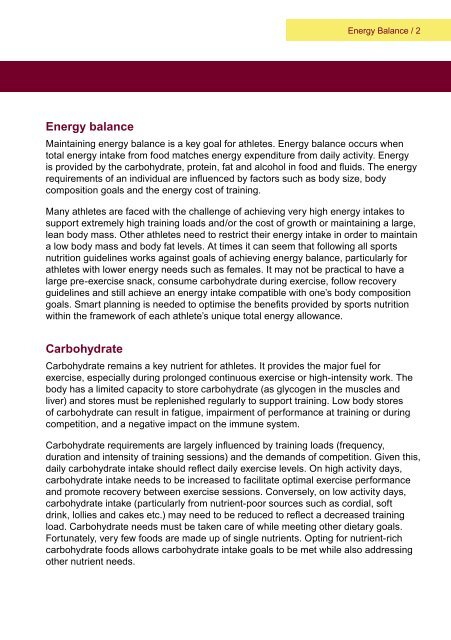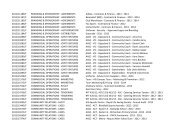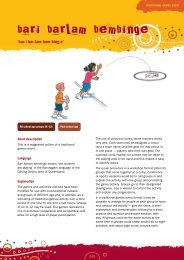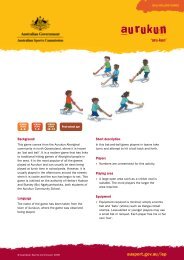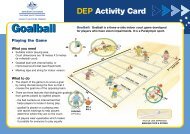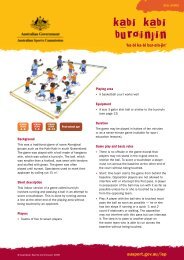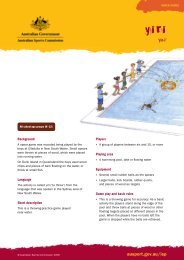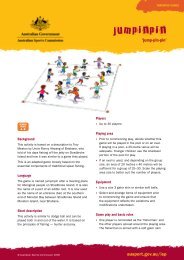Current Concepts in Sports Nutrition - Australian Sports Commission
Current Concepts in Sports Nutrition - Australian Sports Commission
Current Concepts in Sports Nutrition - Australian Sports Commission
Create successful ePaper yourself
Turn your PDF publications into a flip-book with our unique Google optimized e-Paper software.
Energy balance<br />
Energy Balance / 2<br />
Ma<strong>in</strong>ta<strong>in</strong><strong>in</strong>g energy balance is a key goal for athletes. Energy balance occurs when<br />
total energy <strong>in</strong>take from food matches energy expenditure from daily activity. Energy<br />
is provided by the carbohydrate, prote<strong>in</strong>, fat and alcohol <strong>in</strong> food and fluids. The energy<br />
requirements of an <strong>in</strong>dividual are <strong>in</strong>fluenced by factors such as body size, body<br />
composition goals and the energy cost of tra<strong>in</strong><strong>in</strong>g.<br />
Many athletes are faced with the challenge of achiev<strong>in</strong>g very high energy <strong>in</strong>takes to<br />
support extremely high tra<strong>in</strong><strong>in</strong>g loads and/or the cost of growth or ma<strong>in</strong>ta<strong>in</strong><strong>in</strong>g a large,<br />
lean body mass. Other athletes need to restrict their energy <strong>in</strong>take <strong>in</strong> order to ma<strong>in</strong>ta<strong>in</strong><br />
a low body mass and body fat levels. At times it can seem that follow<strong>in</strong>g all sports<br />
nutrition guidel<strong>in</strong>es works aga<strong>in</strong>st goals of achiev<strong>in</strong>g energy balance, particularly for<br />
athletes with lower energy needs such as females. It may not be practical to have a<br />
large pre-exercise snack, consume carbohydrate dur<strong>in</strong>g exercise, follow recovery<br />
guidel<strong>in</strong>es and still achieve an energy <strong>in</strong>take compatible with one’s body composition<br />
goals. Smart plann<strong>in</strong>g is needed to optimise the benefits provided by sports nutrition<br />
with<strong>in</strong> the framework of each athlete’s unique total energy allowance.<br />
Carbohydrate<br />
Carbohydrate rema<strong>in</strong>s a key nutrient for athletes. It provides the major fuel for<br />
exercise, especially dur<strong>in</strong>g prolonged cont<strong>in</strong>uous exercise or high-<strong>in</strong>tensity work. The<br />
body has a limited capacity to store carbohydrate (as glycogen <strong>in</strong> the muscles and<br />
liver) and stores must be replenished regularly to support tra<strong>in</strong><strong>in</strong>g. Low body stores<br />
of carbohydrate can result <strong>in</strong> fatigue, impairment of performance at tra<strong>in</strong><strong>in</strong>g or dur<strong>in</strong>g<br />
competition, and a negative impact on the immune system.<br />
Carbohydrate requirements are largely <strong>in</strong>fluenced by tra<strong>in</strong><strong>in</strong>g loads (frequency,<br />
duration and <strong>in</strong>tensity of tra<strong>in</strong><strong>in</strong>g sessions) and the demands of competition. Given this,<br />
daily carbohydrate <strong>in</strong>take should reflect daily exercise levels. On high activity days,<br />
carbohydrate <strong>in</strong>take needs to be <strong>in</strong>creased to facilitate optimal exercise performance<br />
and promote recovery between exercise sessions. Conversely, on low activity days,<br />
carbohydrate <strong>in</strong>take (particularly from nutrient-poor sources such as cordial, soft<br />
dr<strong>in</strong>k, lollies and cakes etc.) may need to be reduced to reflect a decreased tra<strong>in</strong><strong>in</strong>g<br />
load. Carbohydrate needs must be taken care of while meet<strong>in</strong>g other dietary goals.<br />
Fortunately, very few foods are made up of s<strong>in</strong>gle nutrients. Opt<strong>in</strong>g for nutrient-rich<br />
carbohydrate foods allows carbohydrate <strong>in</strong>take goals to be met while also address<strong>in</strong>g<br />
other nutrient needs.


